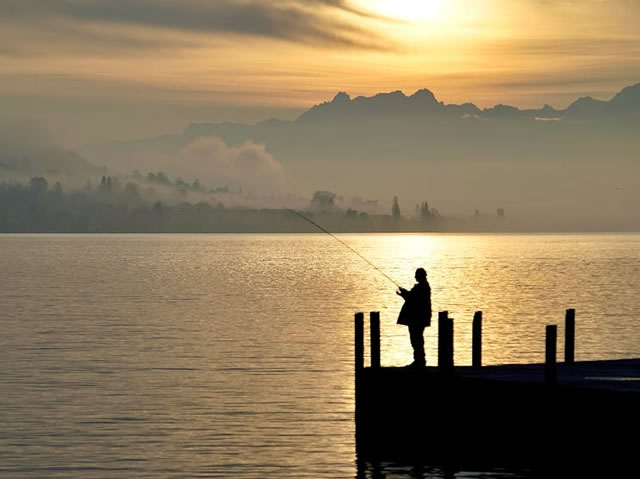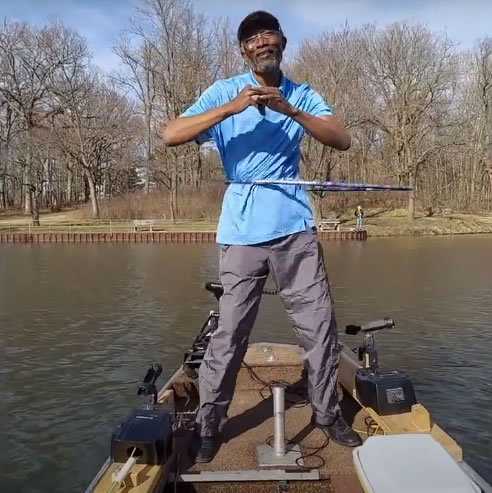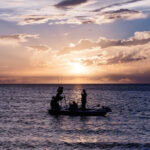In Jesse’s own words…
Best spot fishing makes a substantial difference. Story 6
Location is another crucial factor. Points, coves, and areas with abundant cover such as fallen trees, rocks, and vegetation are prime spots to find bass. Observing the water for signs of activity, such as splashes or jumping fish, can also guide you to the best fishing spots. Patience and persistence are key, as the early morning bite can sometimes be fleeting. However, with the right preparation and a bit of luck, bank fishing for bass at dawn can provide a fulfilling and memorable experience.
Using two rod and reel setups while fishing can offer several significant advantages, enhancing both the efficiency and enjoyment of the activity. Firstly, leveraging two rods allows anglers to cover more water and increase their chances of catching fish. By casting in different areas or at varying depths, anglers can experiment with multiple techniques and bait types simultaneously. This approach can be particularly valuable in unfamiliar waters, where identifying the most productive spots and effective lures quickly can make a significant difference.
Pexel Photo Credits: Thomas Forsberg & Sirikul R
Using Jesse’s own words, we came up with this for content for the website article.
When it comes to bass fishing, choosing the right location can significantly impact your success on the water. Whether you’re fishing from the bank or a boat, understanding where to find bass and how to approach these spots is essential for any angler looking to improve their catch rate. Let’s dive into some key strategies for finding the best fishing spots and making the most of your time on the water.
The Importance of Location in Bass Fishing
Bass are ambush predators that rely on cover to hide and wait for prey. Knowing where to look for bass is the first step to a successful fishing trip. Here are some of the most productive spots to target:
-
Points: Points are areas where the land juts out into the water, creating a natural barrier that fish use to their advantage. Bass often use points as ambush spots because they provide access to deeper water and a place to hide. When fishing points, focus on the edges where the shallow water drops off into deeper areas. This is where bass are likely to be lurking, waiting for baitfish to swim by.
-
Coves and Inlets: Coves and inlets are calm, protected areas where bass often gather. These spots offer shelter from wind and waves and are rich in food sources, such as minnows and insects. Fishing the back of a cove or along the edges where there is cover can be particularly effective, especially in the early morning or late afternoon when bass are more active.
-
Areas with Abundant Cover: Bass love structure and cover, such as fallen trees, submerged rocks, weed beds, and docks. These structures provide shelter, feeding grounds, and ambush points. Casting your lure close to or around these features can increase your chances of a strike. Be mindful of snags, and use lures that can navigate through dense cover, like weedless jigs or Texas-rigged soft plastics.
-
Observing Signs of Activity: Keep an eye out for signs of fish activity, such as splashes, jumping fish, or baitfish breaking the surface. These signs can indicate that bass are actively feeding and can guide you to the most productive spots. Birds diving into the water are also a good indicator of fish presence, as they often feed on the same baitfish that bass are targeting.
The Benefits of Using Two Rod and Reel Setups
One effective strategy for maximizing your chances of success is to use two rod and reel setups. Here’s how this approach can enhance your fishing experience:
-
Cover More Water: Using two rods allows you to cast in different areas simultaneously, effectively covering more water. You can set up one rod with a topwater lure to fish the surface while using another rod with a soft plastic or jig to target deeper areas. This dual approach increases your chances of locating fish quickly and efficiently.
-
Experiment with Different Techniques: Fishing with two rods enables you to experiment with various techniques and baits without constantly switching lures. For example, you can use a fast-moving lure like a spinnerbait on one rod to trigger a reaction strike, while slowly working a jig or worm on the other rod to entice more cautious bass. This versatility allows you to adapt to the fish’s mood and preferences on any given day.
-
Adapt to Changing Conditions: Conditions on the water can change rapidly, especially in the early morning when temperatures and light levels are in flux. Having two rods ready to go allows you to quickly adapt to these changes. If the fish suddenly start feeding on the surface, you can immediately switch to your topwater rod without missing a beat. Conversely, if they move deeper, you can switch to a rod with a deeper-diving lure.
-
Increase Efficiency in Unfamiliar Waters: When fishing in a new location, using two rods can help you identify the most productive spots and effective lures more quickly. By presenting different baits and covering various depths, you can gather valuable information about the fish’s behavior and preferences in unfamiliar waters, increasing your chances of success.
Tips for Managing Two Rods Effectively
While using two rods offers several advantages, it also requires careful management to avoid tangles and lost fish. Here are some tips to help you use two rods effectively:
-
Stay Organized: Keep your rods within easy reach, and make sure your lines are not tangled or crossed. A rod holder or a simple Y-shaped stick can be useful for keeping your rods separated and ready for action.
-
Use Different Rods for Different Techniques: Pair each rod with the appropriate gear for the technique you’re using. For example, use a medium-heavy rod with a fast action tip for jigs and a medium action rod for crankbaits or topwater lures. This setup allows you to quickly switch between techniques without having to adjust your equipment.
-
Pay Attention to Both Rods: It can be easy to focus on one rod and forget about the other, but staying alert and paying attention to both rods is crucial. Watch for any signs of a bite, such as a twitching line or a slight pull, and be ready to set the hook on either rod.
-
Practice Good Rod Placement: Place one rod securely in a rod holder or lean it against a stable surface while actively fishing with the other. This way, you won’t accidentally knock a rod into the water, and you’ll have both hands free to handle a fish once you hook one.
Patience and Persistence: Keys to Success
Fishing, especially for bass, requires a mix of skill, knowledge, and a good dose of patience. Even in prime locations, the bite can be slow or intermittent. The key is to remain persistent and adaptable, constantly observing your surroundings and adjusting your tactics as needed.
Remember, bass fishing is as much about the experience of being outdoors and enjoying nature as it is about catching fish. So, whether you’re casting from the bank with two rods or exploring new waters from a boat, take the time to appreciate the beauty around you and the thrill of the chase.
With the right preparation, strategic use of equipment, and a bit of luck, you can make every fishing trip a memorable adventure.







